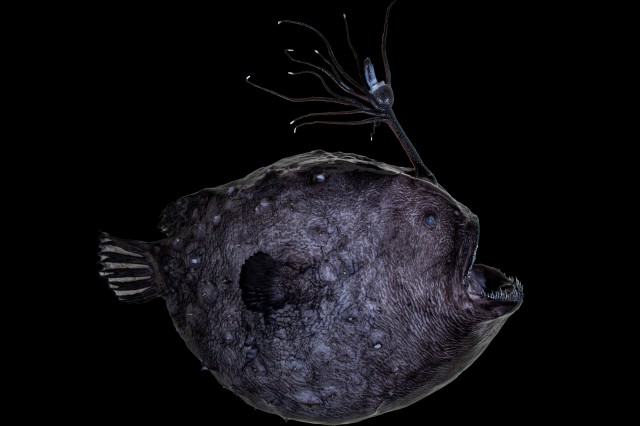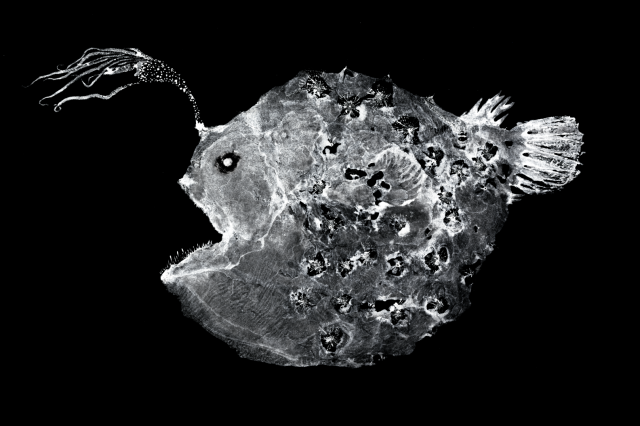Los Angeles, CA (August 19, 2021)—The Natural History Museum of L.A. County (NHM) presents the temporary installation Discovery from the Deep. The display will contain an extremely rare female Pacific footballfish (Himantolophus sagamius, a type of anglerfish), which was discovered in May 2021 at Crystal Cove State Park in Newport Beach, CA. Typically found thousands of feet underwater, this fish now resides in NHMLAC’s Ichthyology Collection, and is one of only about 30 female specimens available for study in museum collections worldwide. Females can get up to ten times larger than males, and intact adult specimens are especially rare.
On view Wednesday, August 25 through Monday, November 29, 2021, visitors will come face-to-face with the deep-sea fish to see it’s sharp teeth; learn about its built-in rod (illicium) and lure (esca), which is filled with bioluminescent bacteria that help attract prey in the light-starved depths of the ocean; touch a model replicating the fish’s spiky exterior; and see its unique pigment before it fades over time. The specimen is displayed in such a way that it is protected from extra light, at the same time mirroring the habitat of the specimen’s natural habitat.
A traditional Japanese gyotaku (fish rubbing, or printing) of the specimen, created by artists Dwight and Hazel Hwang will accompany the presentation. Before the Pacific footballfish was preserved in preparation for storage, the artists covered the fish with organic sumi ink (made from pine soot and water) and then placed a piece of delicate washi (Japanese paper) on top, resulting in a type of print used by fishermen beginning in the 1800s to document catches. Visitors will learn about the traditional Japanese art form, as well as the artists’ personal experience working with the rare specimen.
FREE with General Admission or for Members. For information and to reserve tickets, visit NHM.ORG/anglerfish.
About NHMLAC’s Department of Ichthyology
NHMLAC’s fish collection, housed at the Natural History Museum of L.A. County (NHM), is one of ten internationally recognized ichthyological collections in the United States. Formally called the Robert J. Lavenberg fish collection, it contains nearly three million catalogued specimens, including representatives of most fish families. It also holds special collections of fish eggs and larvae, otoliths, frozen tissues, skeletons, cleared and stained specimens, radiographs and CT scans, in addition to an extensive book and reprint library. Its geographic emphasis is the Pacific Rim, with particular strengths in fishes from the Eastern Pacific, Galapagos, Hawaiian, and Philippine islands, the Antarctic, and the freshwaters of North, Central, and South America. Learn more here.
About the Natural History Museums of L.A. County (NHMLAC)
The Natural History Museums of Los Angeles County (NHMLAC) include the Natural History Museum, La Brea Tar Pits, and the William S. Hart Museum. They operate under the collective vision to inspire wonder, discovery, and responsibility for our natural and cultural worlds. The museums hold one of the world’s most extensive and valuable collections of natural and cultural history—more than 35 million objects. Using these collections for groundbreaking scientific and historical research, the museums also incorporate them into on- and offsite nature and culture exploration in L.A. neighborhoods, and a slate of community science programs—creating indoor-outdoor visitor experiences that explore the past, present, and future. Discover more at NHMLAC.ORG.
MEDIA CONTACT
For interviews and additional imagery, please contact Sally Márquez, smarquez@nhm.org.

